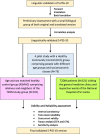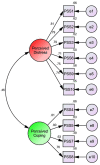Validity and reliability of the Sinhalese version of the perceived stress scale questionnaire among Sri Lankans
- PMID: 37397314
- PMCID: PMC10313401
- DOI: 10.3389/fpsyg.2023.1152002
Validity and reliability of the Sinhalese version of the perceived stress scale questionnaire among Sri Lankans
Abstract
Introduction: Despite the availability of validated psychometrics tools to assess depression, there has not been any validated and reliable tool established to test perceived stress among Sri Lankans. The objective of this study is to test the validity and reliability of the Sinhalese Version of the Sheldon Cohen Perceived Stress Scale.
Materials and methods: Standard and systematic procedures were adopted to translate the original English version of the Perceived Stress Scale-10 questionnaire into Sinhalese. Consecutive sampling was employed to recruit the Type 2 Diabetes mellitus (T2DM) sample (n = 321), and a convenient sampling was used to recruit the Age and Sex matched Healthy Controls (ASMHC) (n = 101) and the Healthy Community Controls (HCC) groups (n = 75). Cronbach alpha was used to assess internal consistency and reliability was determined using test-retest method utilizing Spearman's correlation coefficient. Sensitivity was evaluated by comparing the mean scores of the Sinhalese Perceived Stress Scale (S-PSS-10) and Sinhalese Patient Health Questionnaire (S-PHQ-9) scores. Post-hoc comparisons were done using Bonferroni's method. Mean scores were compared between the T2DM, ASMHC, and HCC groups using the independent t-test. Explanatory Factor Analysis (EFA) was conducted using the principal component and Varimax rotation while the Confirmatory Factor Analysis (CFA) was performed to assess the goodness-of-fit of the factor structure extracted from the EFA. Concurrent validity was assessed using the Pearson correlation between the S-PSS-10 and Patient Health Questionnaire measured by S-PHQ-9 (p < 0.05).
Results: Cronbach alpha values of the three groups T2DM, ASMHC and HCC were 0.85, 0.81, and 0.79, respectively. Results of the ANOVA test suggested that there was a significant difference in the mean scores between groups (p < 0.00). EFA analysis revealed the existence of two factors with eigenvalues greater than 1.0. The factor loadings for the items ranged from 0.71-0.83. The CFA analysis demonstrated a good model fit for the two-factor model S-PSS-10. The S-PSS-10 significantly correlated with S-PHQ-9, indicating an acceptable concurrent validity.
Conclusion: Findings revealed that the S-PSS-10 questionnaire can be used to screen perceived stress among the majority of the Sri Lankan Sinhalese-speaking population specially with chronic illnesses. Further studies with higher sample sizes across different populations would enhance the validity and reliability of S-PSS-10.
Keywords: Sinhala; Sri Lanka; Type 2 Diabetes Mellitus; perceived stress; psychometric; validation.
Copyright © 2023 Mendis, Palihaderu, Karunanayake, Satharasinghe, Premarathne, Dias, Rajapakse, Hapugalle, Karunaratne, Binendra, Kumara, Prabhashwara, Senarath, Yeap, Ho and Dissanayake.
Conflict of interest statement
The authors declare that the research was conducted in the absence of any commercial or financial relationships that could be construed as a potential conflict of interest.
Figures
Similar articles
-
Validation of the Sinhalese Version of Brief COPE Scale for patients with cancer in Sri Lanka.BMC Psychol. 2022 Jun 20;10(1):157. doi: 10.1186/s40359-022-00863-z. BMC Psychol. 2022. PMID: 35725504 Free PMC article.
-
The Chinese version of the Perceived Stress Questionnaire: development and validation amongst medical students and workers.Health Qual Life Outcomes. 2020 Mar 13;18(1):70. doi: 10.1186/s12955-020-01307-1. Health Qual Life Outcomes. 2020. PMID: 32169070 Free PMC article.
-
Psychometric evaluation of the Sinhalese version of MacNew Heart Disease Health Related Quality of Life Questionnaire in patients with stable angina.Health Qual Life Outcomes. 2016 Mar 15;14:44. doi: 10.1186/s12955-016-0448-0. Health Qual Life Outcomes. 2016. PMID: 26980077 Free PMC article.
-
Assessing mental well-being in a Sinhala speaking Sri Lankan population: validation of the WHO-5 well-being index.Health Qual Life Outcomes. 2020 Sep 11;18(1):305. doi: 10.1186/s12955-020-01532-8. Health Qual Life Outcomes. 2020. PMID: 32912245 Free PMC article.
-
Development and validation of a measurement scale to assess nursing students’ readiness for the flipped classroom in Sri Lanka.J Educ Eval Health Prof. 2020;17:41. doi: 10.3352/jeehp.2020.17.41. Epub 2020 Dec 14. J Educ Eval Health Prof. 2020. PMID: 33307616 Free PMC article. Review.
Cited by
-
Diabetes self-management and its influencing factors among adults with type 2 diabetes mellitus in rural Sri Lanka: A cross-sectional study.Belitung Nurs J. 2024 Aug 28;10(4):448-455. doi: 10.33546/bnj.3441. eCollection 2024. Belitung Nurs J. 2024. PMID: 39211462 Free PMC article.
-
Self-management behavior and its influencing factors among adults with chronic obstructive pulmonary disease in Colombo, Sri Lanka: A cross-sectional study.Belitung Nurs J. 2025 Jan 26;11(1):67-74. doi: 10.33546/bnj.3660. eCollection 2025. Belitung Nurs J. 2025. PMID: 39877219 Free PMC article.
-
Prevalence and Predictors of Stress Among Caregivers of Children with Developmental Disorders.J Autism Dev Disord. 2024 Oct 22. doi: 10.1007/s10803-024-06598-7. Online ahead of print. J Autism Dev Disord. 2024. PMID: 39436516
-
Psychometric properties of the perceived stress scale (PSS-10) among pregnant women in China.Front Psychiatry. 2024 Dec 24;15:1493341. doi: 10.3389/fpsyt.2024.1493341. eCollection 2024. Front Psychiatry. 2024. PMID: 39777199 Free PMC article.
References
-
- Bernard R. (2011). Fundamentals of biostatistics. 7th. Boston, MA: Brooks/Cole.
LinkOut - more resources
Full Text Sources




